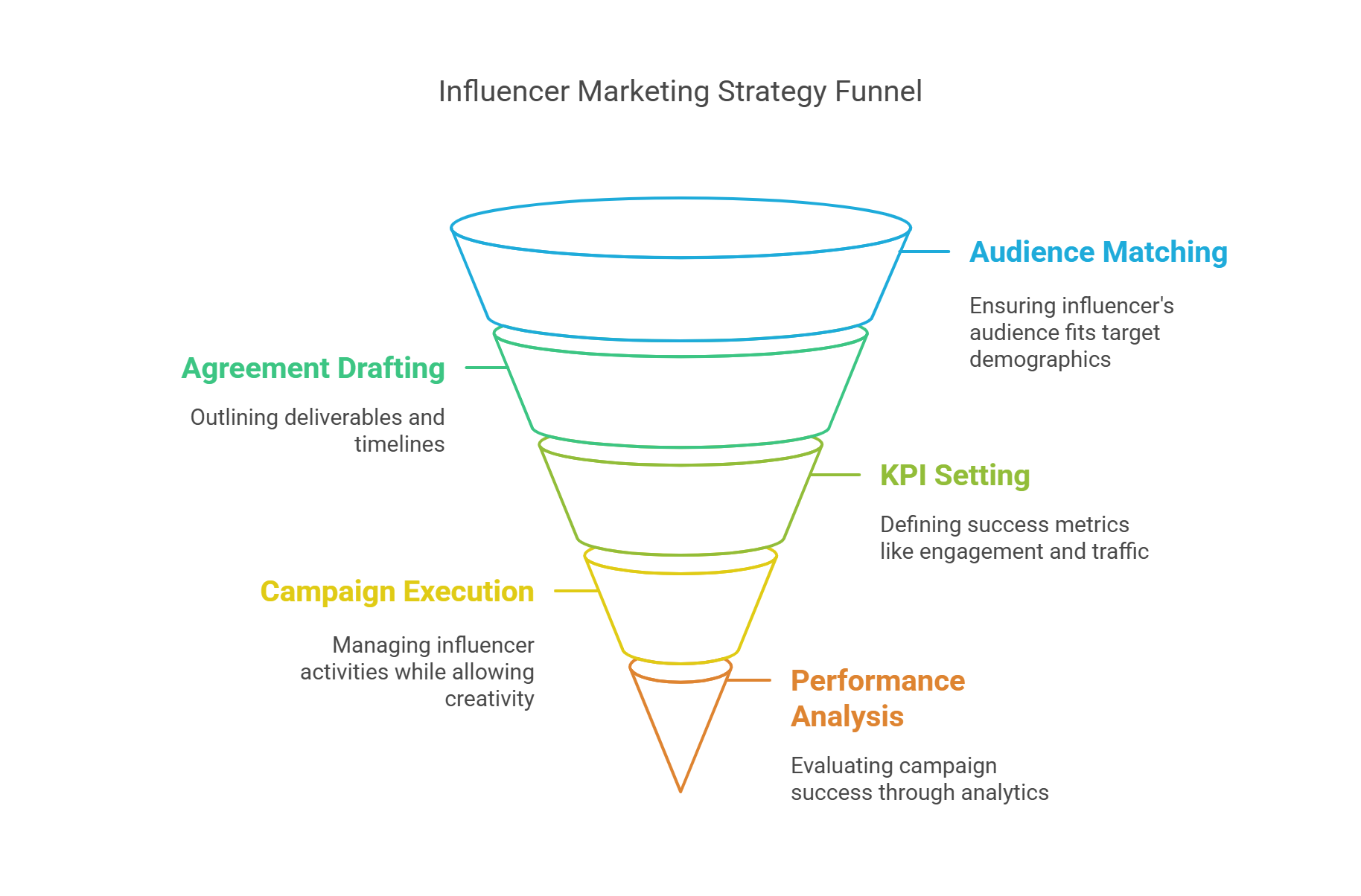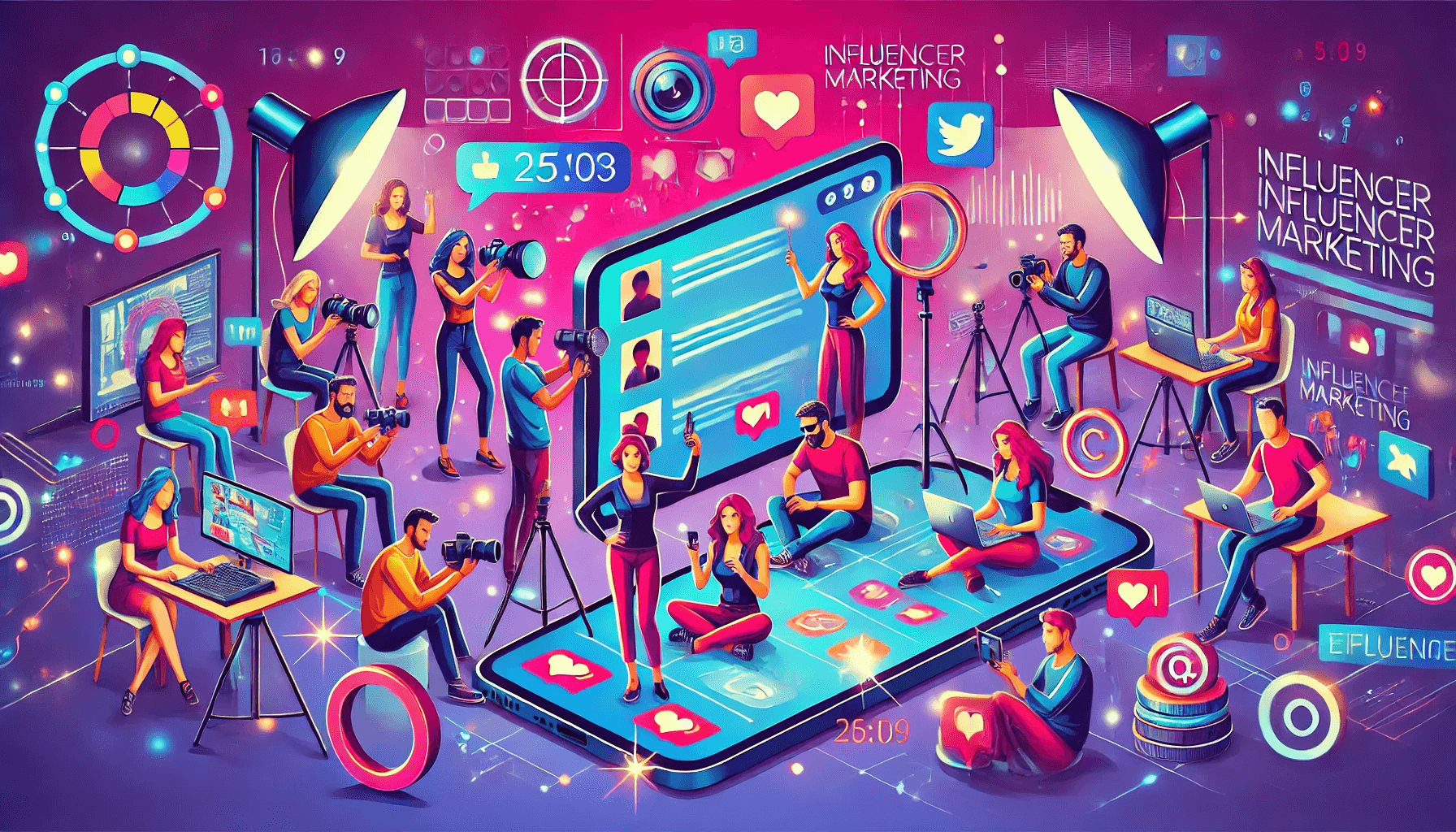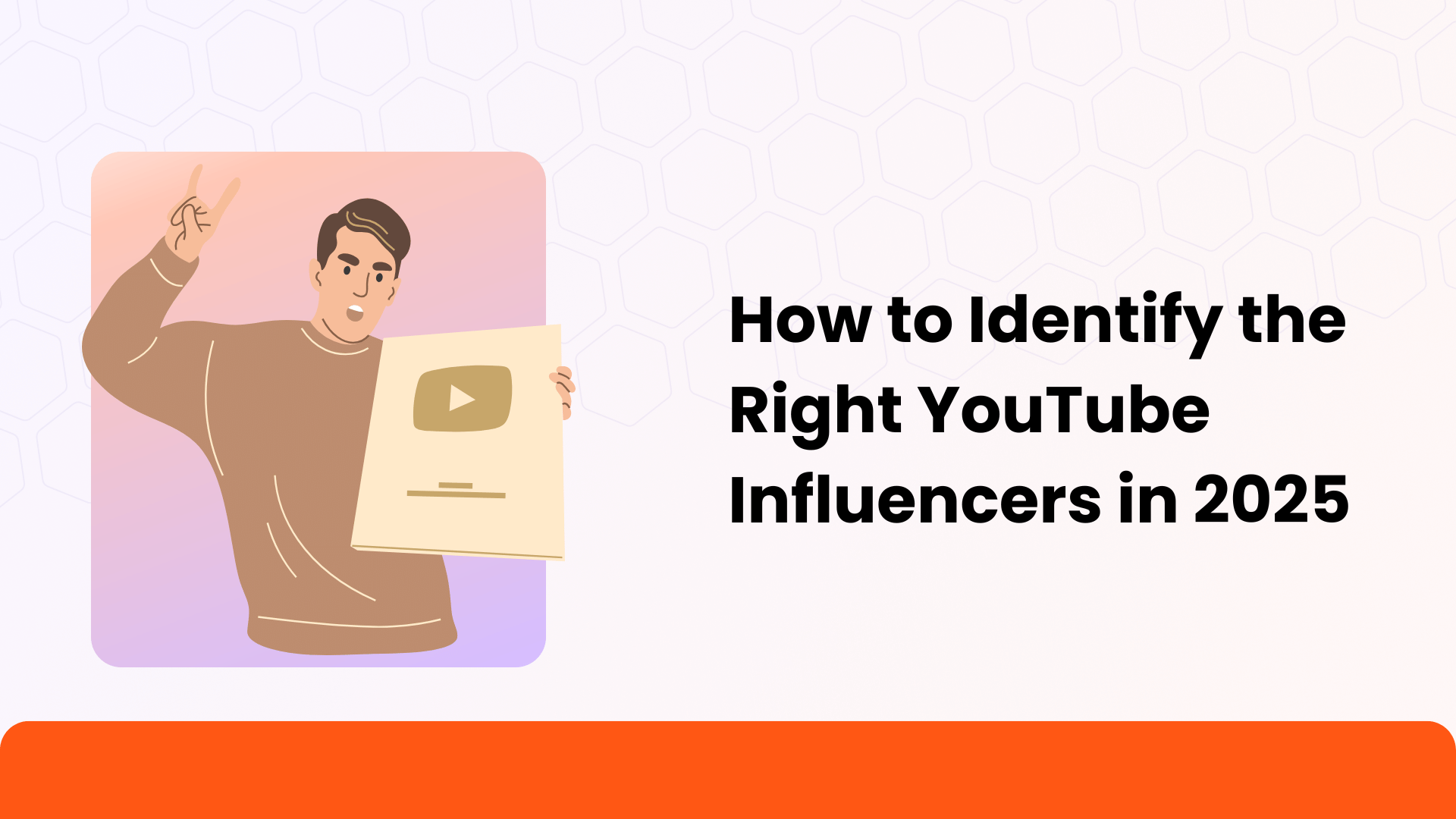As Brain Clark says, “These days, people want to learn before they buy, be educated instead of pitched.” There is no better than leveraging people they trust and facilitating their decision-making process.
And there isn’t a better way to do this than influencer marketing. Whether your goal is to build awareness, drive product consideration, or support sales, influencer marketing is the answer. In this article, we’ll explore how influencer marketing will continue to shape brand growth, from understanding influencer tiers to streamlining campaign processes with the right tools.
What is influencer marketing?
Influencer marketing is an effective strategy for expanding brand recognition and increasing sales of new products, services, or promotions. Influencer marketing uses social media influencers’ trusted endorsement to reach specific target audiences – often in an engaging and enjoyable manner.
When selecting an influencer, it’s crucial that their audience matches your business needs and that they possess all necessary rights and licenses for your campaign. Furthermore, you should draft an agreement outlining timelines and deliverables such as posts, stories or videos; set KPIs accordingly and remain transparent about which analytics you expect at the conclusion of their partnership.
KPIs for your campaign should include engagement metrics like likes, shares and comments as well as brand awareness metrics such as views, clicks and website traffic to measure the effect on social media visibility and website traffic. Finally, keep an eye on follower growth to gauge growth of target audiences.
When selecting influencers, it’s essential that they align with your brand values and complement your message creatively. Look for audience overlap across demographics, psychographics and platform preferences. Strive for an ideal balance between managing an influencer campaign closely and leaving it up to them alone: too much involvement may stifle creativity while too little could prevent authenticity of campaign execution; on the other hand, being too distant could miss opportunities to promote your campaign and expand its audience reach.
Reach out to influencers with proven success at producing results in the past. It’s wise for brands to invest in influencers with high levels of relevance, quality, and engagement with their own followers – this helps build expertise and authority within a field.
Locate potential influencers within your network through recommendations from partners, customers and professional connections. Leverage existing online communities like Instagram or Facebook groups to find influencers with similar audiences as you – mortgage professional Sonja Detrinidad used her succulent-growing community as the launchpad for Partly Sunny Projects, her successful horticulture business.
Once you’ve identified influencers, present a proposal outlining your vision for your campaign and all relevant deliverables and fees associated with working together. Offering compensation such as money or product samples may work. Also consider offering them commission on sales that result from any products they promote and sell for you.

Establishing an influencer strategy is only the first step; businesses must also establish an influencer management workflow to ensure campaigns run smoothly and achieve their campaign objectives. A solid process will prevent miscommunication or alignment issues between teams, creating an ideal partnership that delivers against your campaign goals.
TL;DR
| Focus Area | Details |
|---|---|
| Industry Growth | Influencer marketing projected to reach $22 billion by 2024. |
| Influencer Categories | Mega: More than 1 million followers; Macro: 500K-1 million followers; Mid-tier: 100K-500K followers; Micro: 10K-100K followers; Nano: 1K-10K followers |
| Influencer Benefits | Mega: Large reach; Macro: Broad exposure; Mid-tier: Niche targeting; Micro: Higher engagement; Nano: Highly engaged, intimate audience |
| 2025 Trends | User-Generated Content (UGC), AI Influencers, Social Commerce |
| Key Strategies | Set clear goals, choose the right influencers, use data-driven tools like Qoruz |
| Common Mistakes | Focusing solely on follower count, over-controlling content |
Influencer Marketing vs Social Media Marketing
Influencer marketing focuses on working with individuals who have a significant online following to promote products, brands or campaigns. It prioritizes the influencer’s credibility, authority and audience connection to achieve specific marketing goals such as increasing brand awareness, driving traffic or boosting conversions. Unlike social media marketing, influencers offer a more targeted approach that can reach a specific niche audience and deliver high engagement rates.
In recent years, influencer marketing has become a popular marketing strategy. The concept behind it is simple: create a partnership with an individual who has a strong connection to your target audience, and then have them share or talk about your product in their content. This creates a natural, authentic message about your product or service, which is more likely to drive engagement and sales than a traditional paid advertising campaign.
The most important factor when choosing an influencer is their relationship with your target audience. An influencer’s audience is typically very engaged and trusting, which makes them a good fit for promoting your brand. Influencers are also highly creative, so they can help you craft a story or body of content that will make your influencer promotion seem organic and authentic to your followers.
As a result, influencers tend to have higher conversion rates than traditional ads. In fact, according to one study, influencer marketing has 11x the ROI of paid advertisements. This is due to the fact that influencers are perceived as more trustworthy than ads, and their content is more relatable. Influencers can also provide unique, first-hand experiences with your product, which can increase the chances of followers purchasing it.
When deciding on an influencer, it is also important to consider their demographics. For example, if you’re selling eco-friendly clothing, it is best to work with an influencer who is known for their environmentally conscious lifestyle. Likewise, if you’re selling beauty products, it’s a good idea to work with beauty influencers who use the products in their daily routines.
Lastly, when it comes to paid advertising, it’s vital to know how to optimize your campaigns on different platforms. For example, Instagram is a great platform for running influencer marketing campaigns because it’s easy to track the performance of your campaign with Instagram Insights.
The final difference between influencer marketing and social media marketing is that influencer marketing can be more expensive than traditional advertising. This is because the cost of a campaign can vary depending on how many people you want to reach, the size of your target audience and how long you want to run the campaign for.
However, as social media continues to evolve, it’s becoming more cost-effective for businesses to promote their content through social platforms like Facebook and Instagram. As a result, influencer marketing is expected to continue growing in 2025.
| Social Media Marketing | Influencer Marketing | |
|---|---|---|
| Definition | Promoting products or services directly on social media platforms using ads, posts, and other content. | Partnering with influencers to promote a brand through their social media presence. |
| Who Does the Marketing? | Brands themselves create and share content on their social media accounts. | Influencers, who are individuals with a large, engaged following, promote the brand. |
| Control | Brands control the content and how it is presented. | Influencers have more freedom to present the content in their own style. |
| Audience | Aiming to reach a broader audience through paid ads and organic posts. | Targeting a specific, engaged group that follows the influencer. |
| Content Creation | Brands usually create and post their own content. | Influencers create their own content to promote the brand in a more personal way. |
| Trust Factor | Can be perceived as direct advertising, often seen as less personal. | Influencers have built trust with their audience, so their promotion feels more genuine. |
| Cost | Can vary; brands often pay for ads or sponsored posts. | Often requires paying influencers for their reach or providing free products. |
Types of Influencers
Gone are the days when brands would hire influencers with millions of followers or celebrities. Influencer marketing has evolved over the years, and now there’s space and opportunity for influencers with every following size across different niches.
Based on their following size, influencers are categorized into 5 different categories and each of these categories can help you meet different aspects of your marketing strategy:
1. Mega Influencers – (with over 1 million followers)
Well, these are your typical social media celebrities. Their following size is over 1 million and a big following makes them a perfect fit for your brand awareness campaigns.
Creators like BeerBiceps, Mr. Beast, Prajakta Koli, Kritika Kurrana, etc. fall into this category. Mega influencers are perfect for your influencer marketing efforts for the following reasons:
- Unmatched Reach and Exposure
- Instant Credibility and Brand Association
- Cross-Platform Influence
- High-Quality, Professional Content
- Influencing Consumer Trends
What to consider when Partnering with Mega Influencers?
- High Costs
- Balancing Authenticity
- Tracking and Measuring Impact
2. Macro Influencers (500k – 1 million followers)
Macro-influencers are those with follower counts between 500,000 and 1 million. While mega influencers have a very broad audience base, these influencers come with a perfect blend of reach, credibility, and professionalism.
They understand their audience’s nerves well and create content that reaches the masses while also keeping a sense of community alive. Macro influencers are perfect for your influencer marketing efforts if you are chasing the following goals:
1. Wider Reach for Brand Awareness
2. Credibility and Trust
3. High-Quality Content Creation
4. Professionalism and Experience
5. Cross-Platform Influence
Considerations When Working with Macro-Influencers
1. Higher Costs
2. Ensuring Authenticity
3. Creative Collaboration
3. Mid Tier Influencers (100k-500k followers)
Mid-tier influencers, with follower counts between 100k and 500k, hit the sweet spot when it comes to balancing reach, engagement, and cost. These influencers effectively connect with their audience while delivering strong campaign results, making them ideal for brands looking to scale up without breaking the bank.
What makes them stand out is their niche focus, affordability, and ease of collaboration. If you’re a brand looking to ramp up your influencer marketing efforts without losing engagement or authenticity, mid-tier influencers are your go-to.
Here’s why mid-tier influencers are a smart choice for your campaign goals:
- Broad yet targeted reach
- Higher engagement rates compared to bigger influencers
- Cost-effective without sacrificing impact
- Credibility and expertise in their niche
- Flexibility and creative freedom to fit your brand’s voice
4. Micro-influencers (10k-100k followers)
Micro-influencers are carving out a niche in the influencer world, and it’s not just big names driving results anymore. These influencers, with 10k to 100k followers, have become a powerful tool for brands looking to engage specific, niche audiences and get a real return on investment from their campaigns.
Their strength lies in building strong connections with their followers, making them authentic and trustworthy voices that brands can leverage for effective, targeted campaigns.
So why should brands work with micro-influencers?
- Expertise in specific niches
- Higher engagement rates and deeper connections
- Authenticity and trustworthiness in their content
- Cost-effective and scalable for smaller campaigns
- Better targeting for specific demographics
5. Nano Influencer (1k-10k followers)
Nano influencers, with their 1k to 10k followers, may be small in number, but they have a big influence. These individuals build personal brands and have incredibly strong engagement with their tight-knit communities, making them highly valuable for brands aiming to connect on a deeper level with niche audiences.
Let’s be clear—bigger isn’t always better when it comes to influencer marketing. Nano influencers may not have the reach of macro or mega influencers, but they offer something even more valuable: authenticity and trust. Their content feels less commercialized and more real, which is exactly what consumers are seeking these days.
Here’s why nano influencers are becoming an essential part of marketing strategies:
- Authentic relationships and higher engagement rates
- Trust-building with niche audiences
- Affordability and cost-effectiveness
- Genuine content that feels less like an ad
- Precision targeting for niche markets
In fact, nano influencers boast an average engagement rate of over 4%, making them a powerful tool for brands looking to drive real results.

Benefits of Influencer Marketing in 2025
To speak of numbers, According to our influencer marketing survey, this industry is growing at a CAGR of 25% and the market is expected to reach INR 3375 cr. in FY 2028. So, the numbers reveal that investing in influencer marketing is beneficial. Here are the benefits of influencer marketing for influencers, brands and agencies.
For Influencers
- Build Trust: Influencers can connect with people who trust them. This helps them make more friends and followers.
- Grow Following: By working with brands, influencers can reach new people who like what they do.
For Brands
- Spread the Word: Brands use influencers to help people learn about their products. Influencers talk to lots of people who might want to buy the brand’s stuff.
- Make Strong Friendships: Brands can work with influencers who talk about things they both care about, helping to make real, lasting connections.
- Earn More for Less: By working with influencers, brands can get their name talked about a lot, even without spending too much money.
- Sell More: Influencers help bring people to the brand’s website, leading to more people buying their products.
For Agencies
- Help Clients Grow: Agencies help brands find the right influencers to work with, making sure everyone gets the best results.
- Create Big Ideas: Agencies come up with fun ways to get people talking about brands with the help of influencers.
Key Trends in Influencer Marketing for 2025
We ran a survey of over 40+ influencer marketing managers and brand strategists to discover the new trends in the influencer marketing space. Here are some interesting insights that cannot go unnoticed:
- UGC – User Generated Content
UGC continues to be a game-changer. Brands are embracing content created by real customers, and it’s easy to see why. Whether it’s a photo or video of someone genuinely using your product, UGC brings authenticity to your brand and builds stronger connections with your audience. It’s no surprise that it’s still a major trend going into 2025.
- AI Influencers
AI influencers are no longer just a futuristic concept—they’re here and making a big impact. These virtual personalities offer a new level of creativity and control for brands. They don’t need sleep, and they can engage with followers 24/7, making them a consistent and reliable option for marketing campaigns.
- Social Commerce
Shopping on social media has gone mainstream. Influencers aren’t just recommending products—they’re facilitating purchases right within platforms. Whether it’s a “swipe up” or a “shop now” button, social commerce is transforming how people discover and buy products, making the buying journey much more seamless.
- LinkedIn Influencers
LinkedIn isn’t just for networking anymore; it’s also becoming a key platform for influencer marketing. Industry experts and thought leaders are building strong communities, making LinkedIn a great place for B2B brands to connect with decision-makers. It’s where knowledge meets influence.
- Influencers’ Content Turned Paid Ads
Brands are getting smarter by turning influencer-generated content into paid ads. If a post performed well organically, why not amplify it with a little paid boost? This approach extends the reach of content that’s already resonated with audiences, ensuring your message goes even further.
How to Build an Effective Influencer Marketing Strategy?
Let’s admit, that any marketing initiative has multiple steps involved and various elements need to come together to execute the plan and drive the best results for your brand. Influencer marketing is no different.
Here’s a 6-step guide to building an effective influencer marketing strategy:
- Be research-driven
- Set clear goals and expectations
- Create a Clear Brief
- Choose relevant influencers
- Negotiate collaboration structures
- Be research-driven
Before you go ahead and execute a campaign, it’s important to observe and notice what’s going on in the industry. Observe and analyze what other brands are doing and do not skip spending efforts in studying the kind of content influencers are doing.
Don’t just rely on studying competitors but also other brands with similar audience sets and in different industries to get an insight into different approaches you can take.
For example; As a sports shoe brand, you can see campaigns of brands dealing in fitness wear/ gym clothing as the customer base is similar.
- Set clear expectations and Goals.
Remember, influencer marketing serves as a full-funnel marketing strategy. So, make sure you are very clear on what are your output expectations. Whether you want to build brand awareness, nurture folks by educating them, or drive sales.
Once you are clear on your campaign goal, you can strategize further steps and have a more clear and ROI-focused effort toward the campaign.
- Create clear briefs
Influencers cannot randomly create anything and post promoting your brand. They must get a clear brief mentioning the brand guidelines, value and what is it that you are trying to achieve through the campaign.
But, that does not mean you choreograph each element of the content. Since, creators know their audiences better, gives them creative freedom to integrate the brand and come up with the content that actually represents the brand and reaches the right target audiences.
So, never hesitate to supply the influencer with your outline and expectations from the content.
- Choose relevant influencers
Influencers are a make-and-break for your campaign. Choosing the right influencers with clear demographics is extremely important to let the messaging reach the right people.
Getting the wrong influencer not only costs you money but also time, reach, and potential sales. Let’s admit, that an influencer with a majority male audience cannot be the right fit for something that appeals to women.
Deciding on the right influencer isn’t just a followers game but goes way in-depth with various factors coming into the picture like
- Estimated Reach
- Engagement rate
- Paid partnership engagement ratio
- Audience location
- Audience quality
- Gender ratio
- Audience Age
You can use Qoruz’s Influencer Search feature to discover the right influencers for your campaign. You can search influencers based on advanced parameters to make data-driven decisions for your campaigns.
In fact, the better the influencer brand fit, the more impactful and genuine the brand endorsement will become. Authentic endorsement drives higher action from the audience.
Once you identify the right influencers, you can start reaching out to them.
For macro and mega influencers, you can contact their managers and for mid-tier, micro, and nano influencers, you can directly reach out to them via mail or direct DMs.
- Negotiate Deliverables
Consider building long-term relationships with influencers to build brand loyalty and foster trust among the audience rather than one-off collaboration. Once both parties agree to the collaboration, here are important elements of the collaboration that must be discussed:
- Deliverables: Be clear on the content format. Whether it’s a static post, reel, YouTube video, etc. Decide the duration and quality requirements.
- Timelines: Decide on the deadlines and clarify them to meet them on time.
- Output quality: Clearly specify the output quality expected along with the content structure, quality, and duration of brand integration. You can mention the number of revisions expected if the content doesn’t align well.
Payment structure: Decide whether you are going for a paid partnership, a barter deal, or a PR package style of collaboration. Based on that clearly specify the number of content pieces expected from them and pricing. Influencers are usually open to negotiations, so ensure to negotiate well.
Platforms for Influencer Marketing in 2025
As the influencer marketing industry continues to mature, platforms are becoming an integral part of the process. However, deciding on the right influencer marketing platform remains the biggest challenge.
Different platforms offer different features, so deciding the best influencer marketing platform is a task. Here are a few influencer marketing platforms to look out for:
- Qoruz – Data Driven Influencer Marketing Platform
If you are looking for a platform that offers comprehensive influencer marketing efforts, then Qoruz has to be your choice. After speaking to our existing users, some common points that made Qoruz a go-to choice for them was that it goes beyond surface metrics and gets detailed insights into the campaigns.
Another common highlight we received was the comprehensive nature of the platform for influencer discovery, campaign management, and performance tracking.
Qoruz excels at offering in-depth analytics and a data-driven approach to influencer marketing, ensuring that brands can find, collaborate with, and track the performance of the right influencers. From discovery to campaign management and performance analysis, Qoruz simplifies the entire process, allowing brands to make informed decisions at every step.
The aim is simple – Brands should make data-driven decisions rather than relying on hit-and-trial methods.
- Grin — Best for Large Creator Management
Grin offers a robust creator management system that helps brands find, onboard, and manage influencers across multiple campaigns. It’s a favorite for brands managing large influencer partnerships, offering all the tools needed to scale. It is best for brands managing large influencer pools and e-commerce integrations.
- Infloso — Best for Effortless, AI-Powered Influencer Marketing
Infloso is a powerful influencer marketing platform designed to help brands grow by leveraging word-of-mouth marketing through influencers. With AI-driven solutions, Infloso simplifies the entire process of discovering, managing, and executing influencer campaigns, whether you’re working with 10 or 25,000 influencers. It is best for Brands seeking easy-to-manage, AI-powered influencer marketing campaigns that deliver measurable results.
Read a comprehensive influencer marketing platform analysis here.
How to Verify an Influencer’s Followers
When businesses decide to collaborate with influencers, one of the most important things they need to check is whether the influencer’s followers are real. After all, it’s the real followers who trust the influencer’s opinions, not the fake ones. To ensure your brand’s message reaches the right people, it’s essential to verify the authenticity of an influencer’s followers.
Manually Checking Engagement
One way to spot fake followers is by looking at how much engagement an influencer gets. If an influencer has thousands of followers but only a few likes or comments on their posts, something may be off. Real followers tend to engage with posts by liking, commenting, or sharing. On the other hand, fake followers typically don’t interact much with the content. Another thing to look for is the type of comments. Genuine followers often leave thoughtful, meaningful responses, while fake accounts might just say “Great post!” or leave no comments at all.
Checking the Audience
Another way to verify an influencer’s followers is by examining their audience. If the influencer’s followers don’t match the target audience of your brand, it could be a sign of fake followers. For example, if you’re selling children’s toys but the influencer’s followers are mostly adults, it could mean the followers aren’t relevant to your brand.
Using a Fake Follower Checker Tool
While checking manually can give you some clues, the most effective way to verify an influencer’s followers is by using a fake follower checker tool. These tools are designed to analyze an influencer’s followers and determine how many are real versus fake. For a quick and reliable check, tools like Qoruz’s Fake Follower Checker can provide detailed insights into an influencer’s audience authenticity.
Influencer Marketing mistakes to avoid in 2025
While influencer marketing is highly rewarding considering the kind of results it can drive for your brand, if not done right can directly lead to waste of your marketing budget and also impact the brand reputation.
Here are 4 common influencer marketing mistakes a brand should avoid:
1. Chasing Follower Numbers Over Engagement
A big follower count can be tempting, but if the influencer’s audience isn’t engaged, those numbers mean little. Focus on influencers who have real, active followers who interact with their content regularly.
2. Choosing the Wrong Influencers
Picking influencers who don’t align with your brand’s values or audience can hurt your campaign. Ensure the influencer’s content, personality, and followers are a natural fit for your product to avoid disconnection.
3. Over-Controlling Content
While it’s important to maintain brand consistency, giving influencers too many restrictions can hinder their creativity. Trust them to create content that resonates with their audience — authenticity is key.
4. Failing to Set Clear Campaign Goals
Without specific goals, it’s difficult to measure the success of your influencer marketing. Whether you want more brand awareness, sales, or leads, defining clear objectives helps ensure your efforts deliver real results.
These common mistakes can hinder the success of an influencer campaign, so avoiding them ensures your brand gets the most value from your partnerships.
The Future of Influencer Marketing
It’s clear—influencers are reshaping the future of marketing. But like any fast-moving industry, influencer marketing continues to evolve, and five years from now it might look completely different from today.
While influencer marketing comes with its own set of nuances, setting up a successful campaign follows the same foundational steps as any marketing effort: research, set a budget, define your goals, choose the right influencers, and continuously review and refine. Once you get the hang of it, crafting effective influencer campaigns tailored to your brand’s unique needs will become second nature.
Read this detailed guide to help you decide the right influencer marketing platform.
Frequently Asked Questions
- What does influencer marketing do?
Influencer marketing involves partnering with social media influencers to promote products or services to a targeted audience. These influencers, who have built a loyal following, help brands drive awareness, engagement, and ultimately sales by leveraging their influence on specific audiences.
- What are the 3 R’s of influencer marketing?
Although not explicitly mentioned in the blog, influencer marketing typically revolves around the 3 R’s: Reach, Relevance, and Resonance. These focus on how well an influencer can reach the target audience, how relevant their content is to the brand, and how effectively their content resonates with their followers.
- What is an example of influencer marketing?
A fitness influencer can serve as an instance of influencer marketing by endorsing a sports shoe brand to their followers. They generate content centered on the product, demonstrating its application and advantages, leading to increased interaction and potentially enhancing brand conversions.
4. Is influencer marketing coming to an end?
No, influencer marketing isn’t dying—it’s changing. With brands moving towards authenticity, data-driven intelligence, and long-term collaborations, influencer marketing is getting strategic. Qoruz enables brands to find genuine influencers and track genuine impact, and thus, influencer collaborations have never been better.
5. Is influencer marketing really effective to generate sales?
Yes, but it is dependent on:
- Audience alignment – Ensuring the influencer’s audience matches the brand’s target.
- Influencer credibility – Trust between the influencer and their audience.
- Campaign strategy – Structuring the campaign for maximum engagement and conversions.
While some influencers are monetarily driven, most still maintain a trust relationship with their audiences, leading to high engagement and conversions. With influencer marketing platforms like Qoruz, brands can analyze influencer performance and optimize ROI.
6. How do I track and measure influencer marketing performance?
Tracking influencer marketing requires a combination of analytical tools and strategic know-how:
- Custom Trackable Links – Tools such as HubSpot’s Trackable Link Builder help track influencer-driven traffic.
- Dedicated Landing Pages – Pages specific to influencers monitor conversions effectively.
- Influencer Marketing Platform – Qoruz offers rich insights into influencer reach, engagement, and ROI.
7. Can I promote my app using influencer marketing?
Yes, but organic and quality traffic are essential to avoid invalid traffic policy breaches by platforms like AdMob. A well-balanced app promotion strategy includes:
- Influencer marketing – To generate authentic engagement.
- Google Ads – For targeted paid promotions.
- Affiliate marketing – To expand reach through strategic partnerships.
Qoruz helps brands find the right influencers who generate authentic engagement, ensuring compliance and efficiency.
8. What is the role of influencers, and why do some brands avoid them?
Influencers play a vital role in brand awareness, engagement, and conversions. However, some brands hesitate due to:
- Lack of Authenticity – Some influencers promote products purely for money.
- Consumer Trust Issues – Over-commercialization has made audiences more skeptical.
- Compliance Risks – Industries like Fintech and Healthcare require strict regulatory adherence.




Leave a Comment